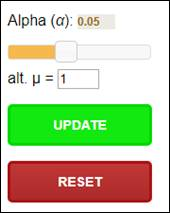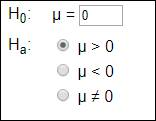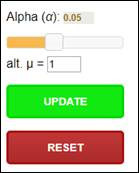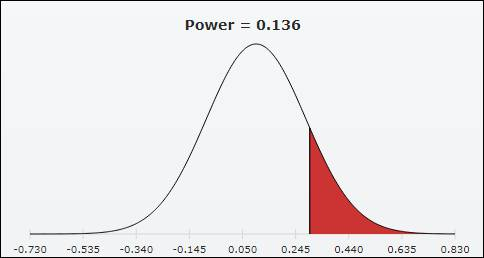
Concept explainers
(a)
To find: The power by using Statistical Power applet.
(a)
Answer to Problem 115E
Solution: The power is 0.885.
Explanation of Solution
Step 1: Go to the “Statistical power” on the website. The screenshot is shown below:

Step 2: Specify “

Step 3: Specify

Step 4: Specify Alpha

The obtained result is shown below:

The obtained power is 0.885.
To find: The power for different values of
Answer to Problem 115E
Solution: The table providing
Power |
|
0.1 |
0.062 |
0.2 |
0.097 |
0.3 |
0.158 |
0.4 |
0.244 |
0.5 |
0.353 |
0.6 |
0.475 |
0.7 |
0.600 |
0.8 |
0.716 |
0.9 |
0.812 |
Explanation of Solution
Calculation:
To obtain the power by using Statistical Power applet, follow the steps below:
Step1: Go to “Statistical power” on the website. The screenshot is shown below:

Step2: Specify “

Step3: Specify

Step4: Specify Alpha

The obtained result is shown below:

The obtained power is 0.062. Now, repeat this process for the other provided values of
Power |
|
0.1 |
0.062 |
0.2 |
0.097 |
0.3 |
0.158 |
0.4 |
0.244 |
0.5 |
0.353 |
0.6 |
0.475 |
0.7 |
0.600 |
0.8 |
0.716 |
0.9 |
0.812 |
To explain: The obtained power.
Answer to Problem 115E
Solution: The power decreases as the alternative changes from one-sided alternative to the two-sided alternative.
Explanation of Solution
(b)
To find: The power.
(b)
Answer to Problem 115E
Solution: The power is calculated as 1.00.
Explanation of Solution
Calculation:
To obtain the power by using the“ Statistical Power applet”, follow the steps below:
Step1: Go to the “Statistical power” on the website. The screenshot is shown below:

Step2: Specify “

Step3: Specify

Step4: Specify Alpha

The obtained result is shown below:

The obtained power is 1.00.
To find: The power for the different values of
Answer to Problem 115E
Solution: The table providing
Power |
|
0.1 |
0.156 |
0.2 |
0.352 |
0.3 |
0.600 |
0.4 |
0.812 |
0.5 |
0.935 |
0.6 |
0.984 |
0.7 |
0.997 |
0.8 |
1.00 |
0.9 |
1.00 |
Explanation of Solution
Calculation:
To obtain the power by using the Statistical Power applet, follow the steps below:
Step1: Go to the “Statistical power” on the website. The screenshot is shown below:

Step2: Specify “

Step3: Specify

Step4: Specify Alpha

The obtained result is shown below:

The obtained power is 0.156. Now, repeat this process for the other provided values of
Power |
|
0.1 |
0.156 |
0.2 |
0.352 |
0.3 |
0.600 |
0.4 |
0.812 |
0.5 |
0.935 |
0.6 |
0.984 |
0.7 |
0.997 |
0.8 |
1.00 |
0.9 |
1.00 |
To explain: The obtained power.
Answer to Problem 115E
Solution: The power increases as
Explanation of Solution
(c)
To find: The power.
(c)
Answer to Problem 115E
Solution: The power is calculated as 1.00.
Explanation of Solution
Calculation:
To obtain the power by using the“ Statistical Power applet”, follow the steps below:
Step1: Go to the “Statistical power” on the website. The screenshot is shown below:

Step2: Specify “

Step3: Specify

Step4: Specify Alpha

The obtained result is shown below:

The obtained power is 1.00.
To find: The power for the different values of
Answer to Problem 115E
Solution: The table providing
Power |
|
0.1 |
0.136 |
0.2 |
0.291 |
0.3 |
0.499 |
0.4 |
0.707 |
0.5 |
0.863 |
0.6 |
0.950 |
0.7 |
0.986 |
0.8 |
0.997 |
0.9 |
0.999 |
Explanation of Solution
Calculation:
To obtain the power by using the Statistical Power applet, follow the steps below:
Step1: Go to the “Statistical power” on the website. The screenshot is shown below:

Step2: Specify “

Step3: Specify

Step4: Specify Alpha

The obtained result is shown below:

The obtained power is 0.136. Now, repeat this process for the other provided values of
Power |
|
0.1 |
0.136 |
0.2 |
0.291 |
0.3 |
0.499 |
0.4 |
0.707 |
0.5 |
0.863 |
0.6 |
0.950 |
0.7 |
0.986 |
0.8 |
0.997 |
0.9 |
0.999 |
To explain: The obtained power.
Answer to Problem 115E
Solution: The power increases as the ‘n’ changes 10 to 30.
Explanation of Solution
Want to see more full solutions like this?
Chapter 6 Solutions
EBK INTRODUCTION TO THE PRACTICE OF STA
- Business discussarrow_forwardAnalyze the residuals of a linear regression model and select the best response. yes, the residual plot does not show a curve no, the residual plot shows a curve yes, the residual plot shows a curve no, the residual plot does not show a curve I answered, "No, the residual plot shows a curve." (and this was incorrect). I am not sure why I keep getting these wrong when the answer seems obvious. Please help me understand what the yes and no references in the answer.arrow_forwarda. Find the value of A.b. Find pX(x) and py(y).c. Find pX|y(x|y) and py|X(y|x)d. Are x and y independent? Why or why not?arrow_forward
- Analyze the residuals of a linear regression model and select the best response.Criteria is simple evaluation of possible indications of an exponential model vs. linear model) no, the residual plot does not show a curve yes, the residual plot does not show a curve yes, the residual plot shows a curve no, the residual plot shows a curve I selected: yes, the residual plot shows a curve and it is INCORRECT. Can u help me understand why?arrow_forwardYou have been hired as an intern to run analyses on the data and report the results back to Sarah; the five questions that Sarah needs you to address are given below. please do it step by step on excel Does there appear to be a positive or negative relationship between price and screen size? Use a scatter plot to examine the relationship. Determine and interpret the correlation coefficient between the two variables. In your interpretation, discuss the direction of the relationship (positive, negative, or zero relationship). Also discuss the strength of the relationship. Estimate the relationship between screen size and price using a simple linear regression model and interpret the estimated coefficients. (In your interpretation, tell the dollar amount by which price will change for each unit of increase in screen size). Include the manufacturer dummy variable (Samsung=1, 0 otherwise) and estimate the relationship between screen size, price and manufacturer dummy as a multiple…arrow_forwardHere is data with as the response variable. x y54.4 19.124.9 99.334.5 9.476.6 0.359.4 4.554.4 0.139.2 56.354 15.773.8 9-156.1 319.2Make a scatter plot of this data. Which point is an outlier? Enter as an ordered pair, e.g., (x,y). (x,y)= Find the regression equation for the data set without the outlier. Enter the equation of the form mx+b rounded to three decimal places. y_wo= Find the regression equation for the data set with the outlier. Enter the equation of the form mx+b rounded to three decimal places. y_w=arrow_forward
- You have been hired as an intern to run analyses on the data and report the results back to Sarah; the five questions that Sarah needs you to address are given below. please do it step by step Does there appear to be a positive or negative relationship between price and screen size? Use a scatter plot to examine the relationship. Determine and interpret the correlation coefficient between the two variables. In your interpretation, discuss the direction of the relationship (positive, negative, or zero relationship). Also discuss the strength of the relationship. Estimate the relationship between screen size and price using a simple linear regression model and interpret the estimated coefficients. (In your interpretation, tell the dollar amount by which price will change for each unit of increase in screen size). Include the manufacturer dummy variable (Samsung=1, 0 otherwise) and estimate the relationship between screen size, price and manufacturer dummy as a multiple linear…arrow_forwardExercises: Find all the whole number solutions of the congruence equation. 1. 3x 8 mod 11 2. 2x+3= 8 mod 12 3. 3x+12= 7 mod 10 4. 4x+6= 5 mod 8 5. 5x+3= 8 mod 12arrow_forwardScenario Sales of products by color follow a peculiar, but predictable, pattern that determines how many units will sell in any given year. This pattern is shown below Product Color 1995 1996 1997 Red 28 42 21 1998 23 1999 29 2000 2001 2002 Unit Sales 2003 2004 15 8 4 2 1 2005 2006 discontinued Green 26 39 20 22 28 14 7 4 2 White 43 65 33 36 45 23 12 Brown 58 87 44 48 60 Yellow 37 56 28 31 Black 28 42 21 Orange 19 29 Purple Total 28 42 21 49 68 78 95 123 176 181 164 127 24 179 Questions A) Which color will sell the most units in 2007? B) Which color will sell the most units combined in the 2007 to 2009 period? Please show all your analysis, leave formulas in cells, and specify any assumptions you make.arrow_forward
- One hundred students were surveyed about their preference between dogs and cats. The following two-way table displays data for the sample of students who responded to the survey. Preference Male Female TOTAL Prefers dogs \[36\] \[20\] \[56\] Prefers cats \[10\] \[26\] \[36\] No preference \[2\] \[6\] \[8\] TOTAL \[48\] \[52\] \[100\] problem 1 Find the probability that a randomly selected student prefers dogs.Enter your answer as a fraction or decimal. \[P\left(\text{prefers dogs}\right)=\] Incorrect Check Hide explanation Preference Male Female TOTAL Prefers dogs \[\blueD{36}\] \[\blueD{20}\] \[\blueE{56}\] Prefers cats \[10\] \[26\] \[36\] No preference \[2\] \[6\] \[8\] TOTAL \[48\] \[52\] \[100\] There were \[\blueE{56}\] students in the sample who preferred dogs out of \[100\] total students.arrow_forwardBusiness discussarrow_forwardYou have been hired as an intern to run analyses on the data and report the results back to Sarah; the five questions that Sarah needs you to address are given below. Does there appear to be a positive or negative relationship between price and screen size? Use a scatter plot to examine the relationship. Determine and interpret the correlation coefficient between the two variables. In your interpretation, discuss the direction of the relationship (positive, negative, or zero relationship). Also discuss the strength of the relationship. Estimate the relationship between screen size and price using a simple linear regression model and interpret the estimated coefficients. (In your interpretation, tell the dollar amount by which price will change for each unit of increase in screen size). Include the manufacturer dummy variable (Samsung=1, 0 otherwise) and estimate the relationship between screen size, price and manufacturer dummy as a multiple linear regression model. Interpret the…arrow_forward
 MATLAB: An Introduction with ApplicationsStatisticsISBN:9781119256830Author:Amos GilatPublisher:John Wiley & Sons Inc
MATLAB: An Introduction with ApplicationsStatisticsISBN:9781119256830Author:Amos GilatPublisher:John Wiley & Sons Inc Probability and Statistics for Engineering and th...StatisticsISBN:9781305251809Author:Jay L. DevorePublisher:Cengage Learning
Probability and Statistics for Engineering and th...StatisticsISBN:9781305251809Author:Jay L. DevorePublisher:Cengage Learning Statistics for The Behavioral Sciences (MindTap C...StatisticsISBN:9781305504912Author:Frederick J Gravetter, Larry B. WallnauPublisher:Cengage Learning
Statistics for The Behavioral Sciences (MindTap C...StatisticsISBN:9781305504912Author:Frederick J Gravetter, Larry B. WallnauPublisher:Cengage Learning Elementary Statistics: Picturing the World (7th E...StatisticsISBN:9780134683416Author:Ron Larson, Betsy FarberPublisher:PEARSON
Elementary Statistics: Picturing the World (7th E...StatisticsISBN:9780134683416Author:Ron Larson, Betsy FarberPublisher:PEARSON The Basic Practice of StatisticsStatisticsISBN:9781319042578Author:David S. Moore, William I. Notz, Michael A. FlignerPublisher:W. H. Freeman
The Basic Practice of StatisticsStatisticsISBN:9781319042578Author:David S. Moore, William I. Notz, Michael A. FlignerPublisher:W. H. Freeman Introduction to the Practice of StatisticsStatisticsISBN:9781319013387Author:David S. Moore, George P. McCabe, Bruce A. CraigPublisher:W. H. Freeman
Introduction to the Practice of StatisticsStatisticsISBN:9781319013387Author:David S. Moore, George P. McCabe, Bruce A. CraigPublisher:W. H. Freeman





